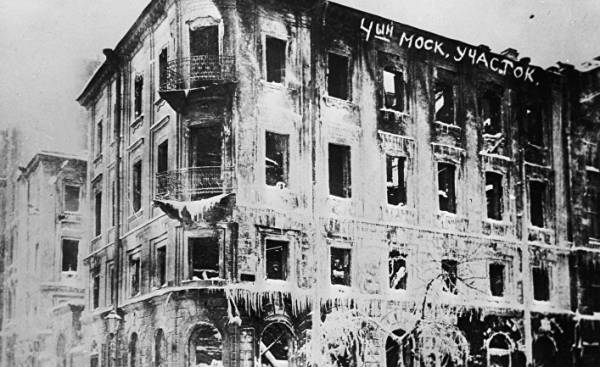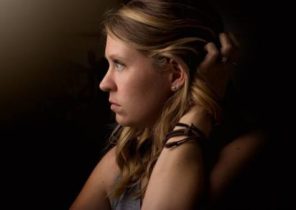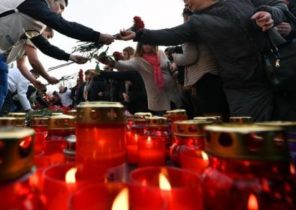
In Russia this year celebrates the centenary of the February and October revolutions. Officially the main theme of the jubilee year proclaimed unity.
Petersburg (in those years, Petrograd) was the center of revolutionary unrest the whole of 1917. For Russians, these memories are still heavy, opinions differ.
In order to understand what was happening at the time, it is necessary to visit the five places connected with the revolutionary events in Petrograd.
Peter and Paul Cathedral: the Royal remains still argue
The clock strikes twelve. The bells of the Cathedral singing “God save the Tsar”.
This is the latest national anthem of tsarist Russia. Now listen to the tourists who, with his head, look at the Golden spire of the tower.
Underneath lie the remains of the last Russian Tsar, his family members and his servants.
The remains of two children, Alexei and Maria, not yet buried because of the disagreement of the Orthodox Church. The Church does not recognize the indisputable affiliation of these remains to the Royal family.
Emperor Nicholas II, Empress Alexandra, their five children, a doctor, a cook and two servants were shot in the basement of the Ipatiev house in July 1918 in Yekaterinburg, in the Soviet period Sverdlovsk. The performers were the Bolsheviks, the secret order came from Moscow.
In the 1970-ies on the orders of the Communist party of the Ipatiev house was destroyed, as was the fear that he will turn into a place of pilgrimage for monarchists.
Peter and Paul Cathedral in this place did not. Hardly anyone from the Russian wants to return to Imperial power.
“It is impossible to present that in Russia will appear again king. The only thing that could be recovered from those times — perfect balls in the palaces,” says 25-year-old Alice. She came to St. Petersburg from the Urals.
The Soviet Union, born of the revolution, 70-year-old Catherine recalls the good word, though regretting the fate of the Royal family.
“I can’t, as young, completely deny the Soviet era. I was a happy Soviet childhood. When I look back, I am happy with my life in those years,” she says.
Accountant Olga Ovsyannikova not going to celebrate the anniversary of the revolution.
“The first thing that comes to mind is bitterness. If the revolution was not, maybe we would not have to pay such a high price for today”, − says Olga Ovsyannikova.
Gallery “Pig’s snout”: Lenin talks with aliens
The name of the gallery speaks for itself: gallery “Pig’s snout” shows art that is not a pleasure for the viewer with his soft picturesque strokes. It grabs greasy myths of revolution and the present time and smearing them on the face of visitors.
At the exhibition “We see the city of Petrograd in the seventeenth year…” in an exhibit, for example, a century-old stuffed pig, which was donated to the Zoological Museum of St. Petersburg. Stuffed pigs did in 1920-m to year.
“The pig was about three years old when she was stabbed. Thus, she is the same age as the revolution, saw it with my own eyes”, − says Nikolay Vasilyev, workshop which is at the end of the gallery.
Source for creative artists is also an existing “conspiracy theory”. The leader of the revolution Vladimir Lenin is talking with the aliens in the film “Mysteries of history”. Portrait of a revolutionary-Bolshevik Leon Trotsky is placed on the network of fast food restaurants KFC instead of its founder, Harland Sanders (Harland Sanders).
“This version from the Internet. Leon Trotsky was assassinated in Mexico in 1940, and moved to the USA and founded a chain of restaurants that spetsializiruyutsya for chicken dishes,” says Vasiliev.
The gallery was founded by a group of artists and musicians “Colhue”, the abbreviation of the band “Sorcery artists”. In its composition there are also a couple of artists representing the St. Petersburg underground of the 1980-ies and the artistic direction of the “Mitki”.
About stuffed pig’s picture of the “Hell of the CPC”, the first government of Soviet Russia. The center of the picture glowing eyes looking at you Lenin.
The devil’s government is depicted in the form of icons. This exhibition was shown on Russian television, but some other exhibitions of the group “Colhue” were closed, or the exposure were removed as separate works. The reason for this was named, for example, insulting the feelings of believers. Formal criminal charges have been filed.
According to Vasilyev, if you’re lucky, the show will not touch.
“We had an exhibition in the halls of the Arena, where she was cursed, revealed a homosexual orientation, which offends believers. The curator didn’t notice, and paintings were exhibited in the city center,” − says Vasilyev.
Profanity in television production and art, the promotion of homosexuality among minors, insult the feelings of believers is prohibited in Russia by law.
The monument to the lamplighter: the historian searches for the voice of the revolution
In Petrograd the revolution called “red Easter”, as people celebrated the achievement of freedom in a state of ecstasy.
Weekdays in the city, plunged into chaos, were quite different.
Professor of the St. Petersburg European University Vladimir Lapin has devoted an entire book to the smells and sounds of St. Petersburg. In it, he created a historical guide to the revolution inherent in the smells, tastes and sounds.
In 1917, residents compared their routes by the sound of trams and horse-drawn tram.
“If it was quiet, it was better to stay home. If again rang the bells, it was safe to go outside,” says Lapin.
Lapin shows the monument to the lamplighter on the Odessa street. The city did not have enough fuel, and was restless, so often lamplighters didn’t leave the house. To be on the dark streets was even more dangerous.
Petrograd at that time was a Metropolitan city with a population of two million people and a large number of soldiers. He was suffering from food shortages caused by the First world war. And it was full of idle returning from the front men.
The city was full of weapons, which kept shooting.
“Petrogradtsy quickly realized the melody of the revolution,” says Lapin.
If it sounded “international” or “La Marseillaise” and you can hear individual shots, it was just a demonstration. If the shots rang out incessantly, and songs was heard, it was better to stay home.
In 1917, the crowds seized the wine cellar and drank their contents.
Police sent to guard the wine warehouses were added to the drinking their contents. To stop drinking, it was decided to pour all the reserves. At the Warsaw station was poured 4 tons of alcohol. Some managed to have snow, soaked.
“You can buy an expensive port wine, poured on snow and then eat it,” Lapin offers those who really want to take in the story.
One sound image of the revolution can be heard in our day in a totally unexpected place: in the football stadium “Zenit”. After the game, the stands full of the husks of sunflower seeds.
In 1917 in Petrograd there were huge reserves of seeds intended for the production of sunflower oil. Seeds gnawed so much that one of the main rhythms of the revolution was the crunch of footsteps on the husks of sunflower seeds.
The cruiser “Aurora”: the legend, which did not fire on the Winter Palace
Grey cruiser stands above the ice of the Neva. His nose is a gun.
On the night of 25 October 1917 the cruiser anchored near the Nicholas bridge. By this time the strategically important places in the city were already in the hands of the Bolsheviks − except the Winter Palace where the Provisional government.
At 21:40 from the bow guns of the “Aurora” was made a volley to give the signal to start the storming of the Winter Palace. Before this signal shot was fired from the Peter and Paul fortress. According to the memoirs of contemporaries, the sound of a gunshot forced to bounce on their seats of spectators who came to the Mariinsky theater to see the ballet “the Nutcracker”.
Later Aurora and volley, produced from her, were numbered among the legends of the revolution.
In fact, from the cruiser at the Winter Palace did not shoot. He was captured almost without resistance. During the assault killed a few people.
Artem came to get acquainted with the story during the school holidays with his teacher Elizabeth.
“The ship is stunningly beautiful”, says Artem.
“This ship is also the symbol of the revolution,” agrees Elizabeth.
The coup doesn’t make her a nostalgic feeling.
“It reminds you of a difficult historical period, which stirred up the whole country.”
The cruiser, which was built in 1900 and took part in the Russo-Japanese war of 1905-1906 and the First world war. His guns fired and during the Second world war. The ship was repaired many times, and in the years 1984-1987 has been restored all of its underwater part.
In 2014, the symbol of St. Petersburg again had to be repaired. Last summer, residents gathered at the waterfront to watch as Aurora returned to her place to become a Museum ship.
It is expected that this year will a huge number of Chinese tourists come to get acquainted with the cradle of the revolution. The cruiser “Aurora” is the first object designed the “red route”. The last point of the route will be the Smolny Institute, where the Chairman of the Senate of Finland Per Evind Svinhufvud (Svinhufvud Pehr Evind) left the official petition for recognition of independence of Finland, received an affirmative answer and met with Lenin.
The Museum of political history of Russia: the former sanctuary of Lenin concentrated on the victims
The sign at the entrance to the Museum of political history reports that the mission of the Museum is the “education of political culture of civil society”. Sounds promising for the modern Russian state Museum, which was originally created as a Museum of the revolution in 1919.
This building was the Lenin and the Bolsheviks from April to July 1917. Lenin delivered a speech to the people from his balcony.
If to take into account the history of the Museum, his contribution to the jubilee year is balanced in its impact.
Exhibition “the Revolution in Russia. 1917-1922” brings to the forefront the suffering brought a coup. She tells of the chaos, which lasted for six years and “destroying human and economic potential of the country” in a time when social classes, the state, the nation and political forces were fighting for their interests.
Probably, the visitors hinted that such a revolution, Russia no longer wants.
Visitors are introduced consistently with the First world war, February revolution, October revolution and their consequences.
At the end of the exhibition concludes that the consequences of the revolution are felt in Russian society today. In the period 1917-1922 according to various estimates, killed 8 to 13 million people.
The building was the sanctuary of Lenin in the years of Soviet power. Living so many years near Elena Isakova (58 years) does not even want to look in the Museum, what would a modern exhibition. In the years of Soviet schoolchildren were brought here on major holidays mandatory Leninist excursions.
“From one of the Museum halls make me sick,” says Isakov.
She notes that neither President Vladimir Putin nor Prime Minister Dmitry Medvedev are unable to say “no” to the Communists, the Communist heritage left to live.
The Communists, who are now acting at the behest of the Kremlin, in the early 2000-ies was a serious opposing force for Putin.
“A hundred years have passed and it is too small. I think the revolution has rejected Russia many years ago, and the fruits of that revolution we are reaping today,” says Isakov.







